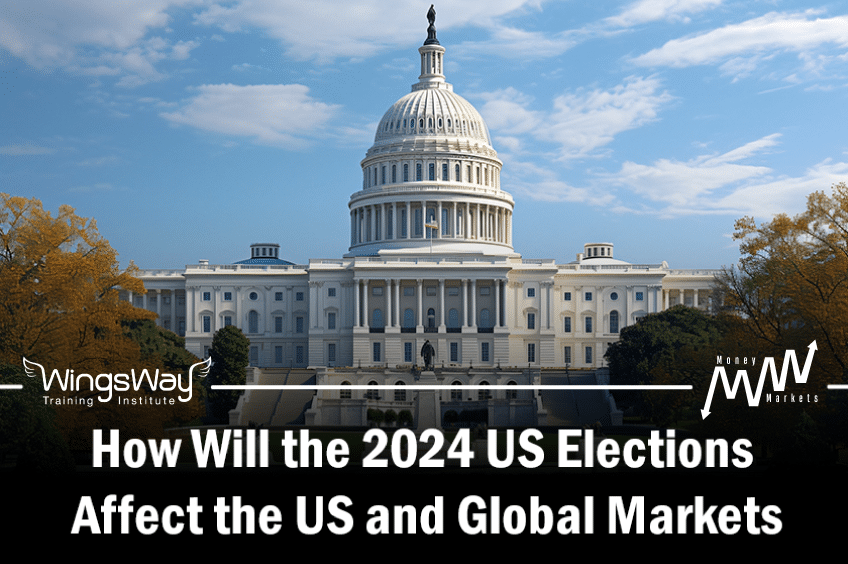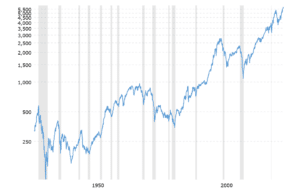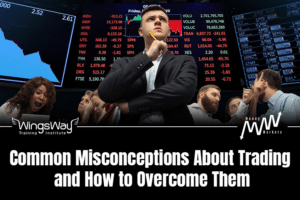
How Will the 2024 US Elections Affect the US and Global Markets
As we approach the US 2024 elections, market uncertainty is heating up, and the big question on every trader’s mind is: How will these elections affect both US and global markets?
While markets have a tendency to swing during election periods, it’s important to understand other factors that contribute to market volatility and how volatility can be a trader’s best friend and investors dream to add into long-term positions at short-term discounted prices.
Historical Context of Election-Driven Impact on Global Markets
During election periods, markets often become more volatile. But historical data reveals a nuanced relationship between elections and market performance.
While it’s tempting to assume that one political party or candidate will cause a particular market reaction, broader economic indicators, such as interest rates and earnings, often play a more decisive role.
Historically, markets have shown stronger returns during Democratic presidencies. For example, studies indicate that the market has averaged a 10.6% return under Democratic presidents versus 4.8% under Republicans.
But there are exceptions. Take the 2016 election—markets initially reacted with uncertainty to President Trump’s win, experiencing a short-term dip.
However, as the administration introduced corporate tax cuts and deregulation policies, the S&P 500 saw significant gains over the following months. This illustrates how, while political shifts can impact short-term volatility, long-term market fundamentals tend to hold more influence.
💡Pro tip: When trading around the election months, ensure that you’re not holding too many positions or positions with larger size overnight. The pre-market and post-market sessions often carry a lot of volatile action that can expose your invested capital to unnecessary risks.
Policy Uncertainty and Election Volatility
Policies and proposals introduced during election seasons by the candidates often affect investor sentiment, particularly when they target taxes, trade, or regulation.
The 2020 election is a good example: markets fluctuated as they tried to anticipate President Biden’s corporate tax rate changes, which many thought might lower earnings numbers, especially for large tech companies. Interestingly, while tech stocks saw some initial uncertainty, the sector quickly rebounded, underscoring that policy-driven market reactions aren’t always straightforward.
For traders, this heightened period of policy uncertainty can present strategic opportunities. In 2012, for example, as discussions heated up around the Affordable Care Act (ACA), healthcare stocks became especially volatile and the sector heated up. This presented many opportunities to trade short-term and for investors to buy up healthcare for their long-term portfolios.
The 2024 election is currently nearly tied between Trump and Kamala. Both have strong stances with respect to some certain policies. Trump stands by clauses like “sending illegal immigrants back to where they came from” and enacting multiple executive orders to imprint his power in the democracy. Kamala on the other hand is all about stopping the massacre in Gaza and increasing tax rates in the US to support government projects.
Traders who could predict these shifts or capitalize on short-term price swings using options strategies found profitable opportunities. In election seasons, short-term tools like options and futures can allow traders to benefit from volatility without committing to a long-term directional position.
💡Pro tip: Pay attention to the daily news and do research about what the presidential candidates and their parties stand for and the policies they will support/introduce during their tenure. For example, Kamala is looking to increase corporate tax rates which could hurt big companies as they have lower spending capital.
Potential Impact on Major Sectors
The impact of election outcomes on specific sectors can be dramatic. For example, healthcare stocks have shown heightened sensitivity to election results. In 2008, with the election of President Obama and the rollout of the ACA, healthcare stocks saw initial volatility as the industry adjusted to the new regulatory landscape.

Source: ING
Energy stocks also face similar election-driven sensitivity. Under President Biden, energy companies, especially those in fossil fuels, experienced pressures as the administration emphasized renewable energy initiatives.
For the tech sector, both major parties have proposed regulations on big tech companies, but responses differ. Historically, the Republican-led government focuses on fostering business growth with fewer regulations, while Democratic-led administrations push for more consumer protections.
💡Pro tip: Identify which sectors were hot in the past and the sectors that could get hot in the next 4 years. Move money out of over-saturated sectors and into the new hot sectors. Traders often shift focus from one sector to the other based on the volatility and volume in that sector.
Tech was very hot under the 2016 Trump presidency due to the low-interest rate environment and his lack of oversight on anti-competitive monopolistic behaviors of big tech.
Global Implications of the 2024 US Elections
The US election results have far-reaching effects, especially on global markets. For instance, under the Trump administration, trade policies, particularly with China, had significant impacts on global supply chains.
When the US imposed tariffs on China in 2018, markets worldwide reacted, with emerging markets hit particularly hard due to reliance on the US-China trade relationship. Following that, the 2020 election and Biden’s subsequent policy of international re-engagement restored some confidence among global markets, impacting sectors ranging from European luxury goods to Asian tech exports.
Currency markets, too, are influenced by US elections. In 2016, when Trump won the election, the dollar initially strengthened, only to fall later on as policies became clearer.
Emerging markets often see indirect impacts, with interest rates, trade volumes, and foreign investments shifting in response to US policy changes. For traders with an eye on global markets, this interplay between the US and world economies is key to anticipating trends in foreign currencies and international stocks.
Understanding the political standings of each candidate and their respective allies in other countries will eventually shape up the relations between those countries for years to come.
Tactical Opportunities for Traders
Elections offer a perfect environment for tactical trading. The market’s anticipation of potential election-driven volatility can lead to a spike in options trading. Traders can take advantage of short-term price movements, even without committing to a specific directional bet. This is especially useful when market predictions are less certain. Furthermore, the knowledge about being able to make money whether the markets move up or down is essential in a volatile environment.
During the 2016 elections, the VIX (volatility index) spiked in anticipation of the election outcome. Traders who capitalized on increased volatility through options or futures had the chance to make profitable trades based on the volatility itself, without needing to predict the winner.
💡Pro tip: VIX is a measure of volatility in the US stock market. When the VIX is high (above 28, usually), it is a great idea to sell Options and collect premium as the VIX will eventually come down once the elections are decided and the Vega component of an Options premium causes it to get crushed in value.
Long-Term Wealth Building Amid Election Cycles
Despite the temptation to react to every market fluctuation during an election year, long-term strategies tend to perform better. For instance, research shows that the S&P 500 has had positive returns in 19 of the 23 presidential election years since World War II. This reflects the resilience of the market despite short-term political uncertainties.
In 2000, after the close and controversial election of George W. Bush, the market saw initial instability, yet the S&P 500 eventually regained momentum. If you look at the line chart below, you will notice its exponential upward trajectory going as far back as the 1900’s. This goes to show that the long-term outlook in the stock market is skewed positively, to the upside, and all short-term pullbacks are simply opportunities to buy more and build wealth.

Source: Macrotrends
Focusing on long-term fundamentals rather than short-term political outcomes can provide a strong foundation for wealth building. While some sectors may experience short-term volatility, understanding cyclical trends and economic fundamentals can guide a stable approach. Most investors view and dips in prices during the election cycles as great opportunities to stock up on more inventory of shares of companies as it is a period of “sale” to them in the long-term upward growth trajectory of the markets.
The Importance of Trading Education for New Investors in Navigating Elections
If you’re thinking, “should I buy stocks before the election?”, the answer is not that black and white.
Having a strong foundational education about the stock market is important to navigate the volatility that comes with elections. Learning from past cycles and understanding the tools available to trade and invest mindfully is important for traders to make confident and informed decisions and get better returns.
For example, traders who understood options trading during the 2020 election had more flexibility to hedge their portfolios and capitalize on volatile conditions.
A stable foundation in stock Options trading and risk management can make a difference between speculative trades driven by media hype and informed decisions grounded in strategy.
At WingsWay Training Institute, we offer beginner-friendly to advanced-level stock market trading courses designed to help you build these skills. From learning to interpret policy shifts to mastering Options strategies and trade shares, our courses equip you to make more calculated moves.
Sign up today and be prepared for what lies ahead!


